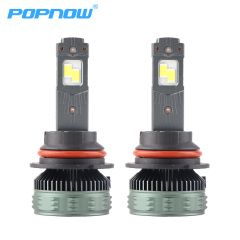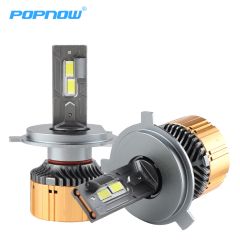LED headlights have gained popularity because they're energy-efficient, long-lasting, and provide exceptional lighting compared to other types. However, like all technologies, they aren't without their issues. Despite their many benefits, LED headlights can develop some problems. Here, we will discuss some of the most common problems and how to fix or prevent them.
1. LED Headlight Flickering
LED headlight flickering, also known as strobing or flashing, is a common problem. It frequently occurs if the LED bulb doesn't integrate properly with the car's electrical system. Often, the issue manifests because of the substantial difference in power need between LED bulbs and traditional halogen or HID bulbs. For instance, if the LED headlights are not getting stable power, they may flicker or flash intermittently. Retrofit LED bulbs, in particular, are prone to these issues.
To solve this problem, you can install resistors or an LED decoders between the bulb and the power source, acting as a buffer. They regulate the current, ensuring the LED headlights receive constant power and reduce or eliminate flickering.
2. Bad Bulb Fitment
Another common problem is incorrect bulb fitment where the bulb isn't appropriately seated or installed in the holder. This improper fit can lead to the LED headlights not working correctly, getting damaged, or causing a weak beam.
You can solve this by verifying the bulb size before purchase and installation. When installing, ensure that the bulb is fitted securely in the holder and the headlamp. If necessary, consider using headlight adaptors that can help provide a secure fit for the bulb.
3. High Glare
LED headlights are known to produce intense light emissions that can lead to high glare. This might not only decrease visibility but also may irritate or blind oncoming drivers, especially when improperly installed.
To fix this, consider professional installation or consult with professionals to ensure your LED headlights are well-aligned and correctly aimed. Further, choosing LED bulbs with low color temperatures like 6000K or below can help reduce glaring light.
4. Poor Heat Dissipation
Despite being energy-efficient, LED headlights generate heat. While not comparable to halogen or HID bulbs’ heat output, LED headlights are sensitive to high temperatures. Without proper heat management, LED headlights can have a significant reduction in lifespan and overall productivity.
Most LED headlight manufacturers counteract this by integrating cooling mechanisms. Still, poor ventilation, incorrect installation, or a malfunctioning cooling fan can lead to overheat problems.
If LED headlights are operated at high temperatures, their internal components may be damaged. This can result in dimmed LED lights, distorted colors, or even losing their ability to emit light altogether.
To solve this problem, make sure the cooling system of the LED headlight is good. Make sure your vehicle's air intakes and vents are clean to ensure adequate air circulation. Also, consider purchasing an LED headlight with an effective heat dissipation design, such as models with aluminum heat sinks or cooling fans.
5. Electromagnetic interference
LED headlights may interfere with the vehicle's electronics, especially the car's radio and wireless communications equipment. This electromagnetic interference may cause radio signal interference, noise, or trailer interference.
To solve this problem, use LED headlights that comply with international electromagnetic compatibility standards such as ECE R10. These lamps have been specially designed to reduce electromagnetic radiation, ensuring that they do not interfere with electronic equipment in the vehicle.
6. Water Evaporation and Atomization
Because LED headlights are often made up of multiple components, some owners may report issues with misting or evaporation from the light housing. This can be caused by temperature changes, a humid environment, or an issue with an incomplete seal.
To combat this, make sure the LED headlights are well-sealed and use fixtures with a waterproof or fog-proof design. In addition, regularly check whether the lampshade is cracked or damaged, and replace or repair it in time.
Summarize:
LED headlights are an advanced lighting technology, but they're not perfect. Common problems include: flickering, incorrect installation, high glare, thermal dissolution, electromagnetic interference, and water evaporation and fogging. To solve these problems, car owners can choose appropriate solutions, such as using a voltage stabilizer, confirming correct installation, adjusting the lighting angle of the lamp, ensuring good heat dissipation and sealing the lampshade, etc. If you encounter serious problems or situations that cannot be solved, it is best to ask professional technicians to provide support and help to ensure that the LED headlights work normally and meet safety requirements. You can also try our canbus LED Headlight bulbs, or LED Headlight warning canceller.







